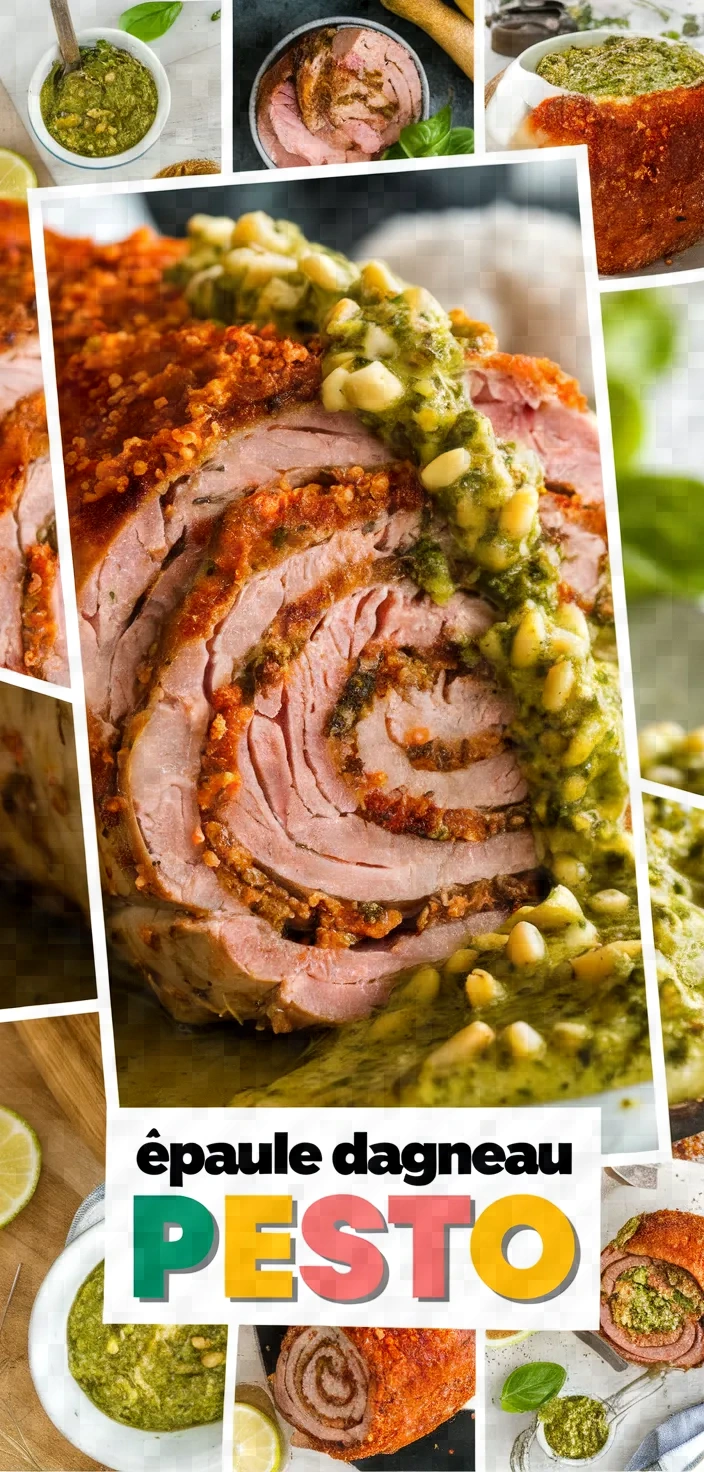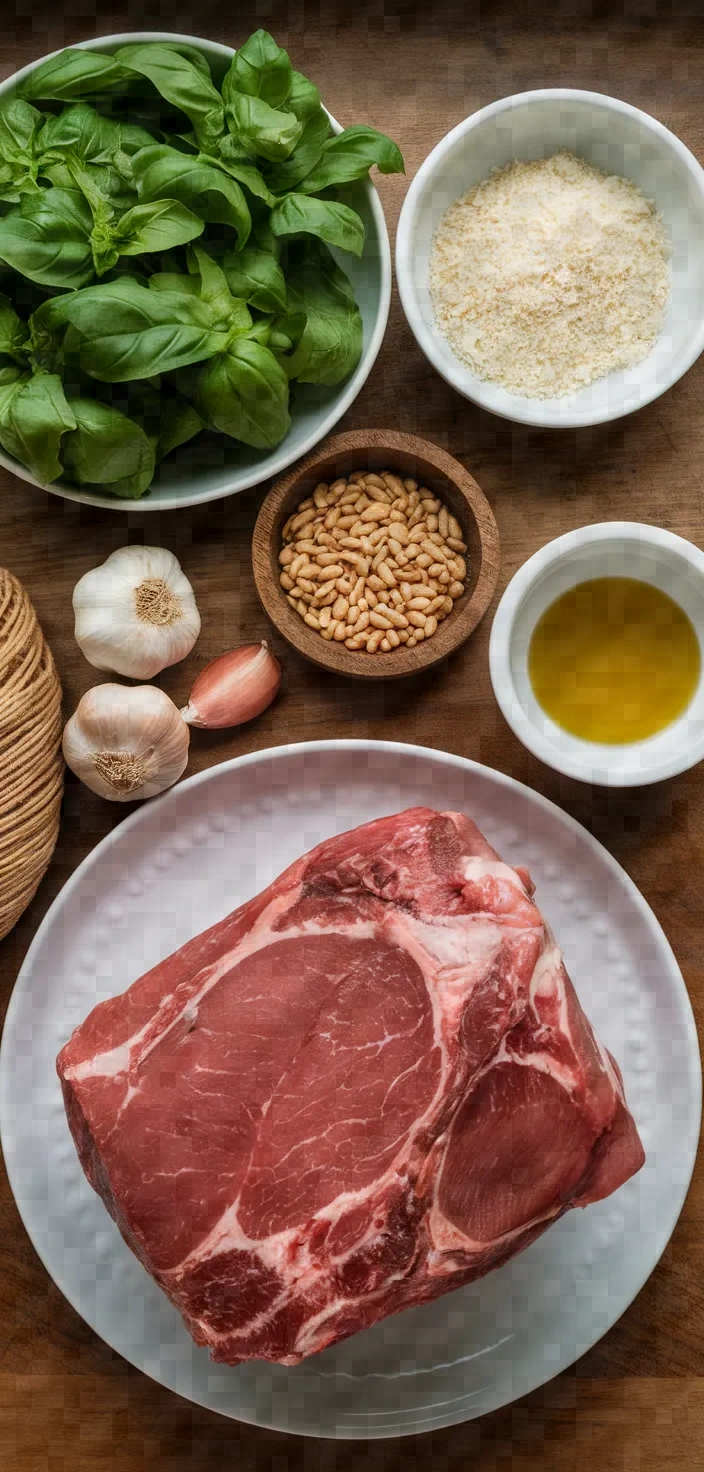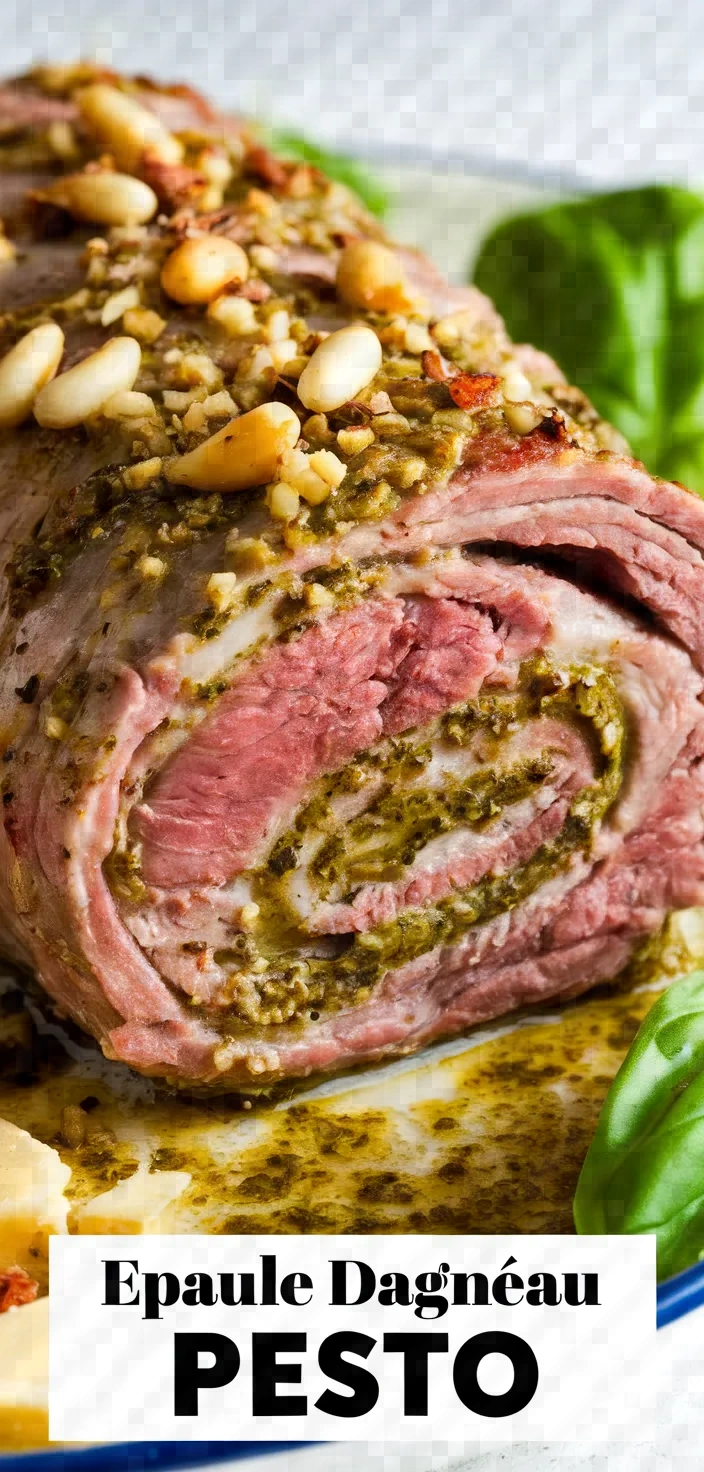I recently discovered a recipe for pesto-stuffed lamb that will have you feeling like a gourmet chef in your own kitchen—trust me, it’s as impressive as it sounds!

I love creating plates of food that celebrate the true nature of flavor in my most traditional recipes. My Epaule D’agneau Roulée au Pesto pairs succulent lamb shoulder with a bold, vibrant basil pesto.
This dish is a powerhouse of the antioxidants that fresh basil is known for and is packed with healthy fats that come from using only extra-virgin olive oil.
Epaule Dagneau Roulee Au Pesto Recipe Ingredients

- Boneless Lamb Shoulder: Rich in protein, contributes a savory, tender flavor.
- Fresh Basil Leaves: Provides vibrant, aromatic freshness, a source of vitamins A and K.
- Parmesan Cheese: Adds umami depth, high in calcium and protein, minimal carbohydrates.
- Pine Nuts: Tender, nutty flavor, source of healthy fats and magnesium.
- Garlic: Infuses a pungent aroma and flavor, offers potential heart health benefits.
- Extra-Virgin Olive Oil: Smooth texture, rich in beneficial monounsaturated fats.
Epaule Dagneau Roulee Au Pesto Recipe Ingredient Quantities
- 1 boneless lamb shoulder (approximately 1.5 kg)
- 2 cups fresh basil leaves
- 1/2 cup grated Parmesan cheese
- 1/3 cup pine nuts, lightly toasted
- 2 cloves garlic
- 1/2 cup extra-virgin olive oil
- Salt and freshly ground black pepper to taste
- Butcher’s twine for tying
How to Make this Epaule Dagneau Roulee Au Pesto Recipe
1. Set your oven to 180°C (350°F) to warm up.
2. In a food processor, blend together the basil leaves, the grated Parmesan cheese, the pine nuts, and the garlic. Pulse until you have a concoction that is the right degree of “chop” for a moist and spreadable pesto.
3. With the processor running, gradually add the olive oil, allowing it to blend in smoothly with the other ingredients. Once it’s all mixed together in a homogenous way, you can taste it and really get an idea of how the flavor is coming together. If you think it needs something, add it! More Parmesan, more nuts, more vinegar, more oil; whatever you think it needs. I add salt and pepper, too.
4. Place the deboned lamb shoulder on a clean surface, with the skin facing down.
5. Evenly distribute the prepared pesto over the inside of the lamb shoulder.
6. Tightly roll the lamb from one end to the other, making sure the pesto filling remains inside.
7. Bind the rolled lamb firmly with butcher’s twine in 5 cm (2-inch) intervals to keep it in shape. With butcher’s twine, 5 cm (2-inch) intervals are close enough to keep the rolled lamb securely tied and holding its shape. If it were too far apart, the rolled lamb would not hold its shape very well.
8. Add extra salt and pepper to the rolled lamb’s exterior.
9. Put the lamb in a roasting pan and roast it in the preheated oven for
1.5 to 2 hours, or until the internal temperature of the meat hits 60°C (140°F), which is the mark for medium-rare.
10. Take the sheep out of the oven. Cover it lightly with aluminum foil. Allow it to sit for 15 minutes. Cut it. Serve it.
Epaule Dagneau Roulee Au Pesto Recipe Equipment Needed
1. Oven
2. Food processor
3. Measuring cups
4. Measuring spoons
5. Cutting board
6. Knife
7. Roasting pan
8. Butcher’s twine
9. Aluminum foil
10. Instant-read meat thermometer
FAQ
- Can I use a different type of nut instead of pine nuts for the pesto?Certainly! You can swap out pine nuts for walnuts or almonds, which will impart a different, yet delicious flavor, to your pesto.
- What is the best way to roast the pine nuts?Toast them lightly in a dry skillet over medium heat until they are golden and aromatic, which should take about 3-5 minutes.
- How do I keep the pesto from darkening?Putting the basil in water that is boiling for only a few seconds and then cooling it in ice water can help keep the pesto looking and tasting fresh as if it had just been made. It can also keep the pesto from separating.
- Can I prepare the lamb and pesto ahead of time?Indeed, the pesto can be prepared a day prior and kept in the fridge, topped with a thin layer of olive oil, to stop it from oxidizing. The lamb can be rolled and tied several hours before it goes into the oven and can hang out in the fridge until it’s ready to roast.
- What is the ideal internal temperature for cooked lamb?For a medium-rare lamb, target the internal temperature of 60°C (140°F). Achieve accuracy with a meat thermometer.
- Is there an alternative to using butcher’s twine for tying the lamb?If butcher’s twine is not available, you can use kitchen cotton string or unwaxed dental floss as alternatives.
Epaule Dagneau Roulee Au Pesto Recipe Substitutions and Variations
Fresh spinach leaves or fresh arugula can be used instead of fresh basil leaves for a different flavor profile.
Substitutes for grated Parmesan cheese may be Pecorino Romano cheese or Grana Padano cheese. These cheeses may offer different tastes, but they can work in a similar way.
Pine nuts can be replaced with walnuts, almonds, or cashews.
Avocado oil or walnut oil can be substituted for extra-virgin olive oil.
Unflavored, unwaxed dental floss can be used to tie the lamb in place of butcher’s twine.
Pro Tips
1. Marinate Overnight for Enhanced Flavor If you have the time, prepare the pesto a day ahead and marinate the lamb shoulder overnight in the refrigerator. This allows the flavors to penetrate the meat more deeply, resulting in a more flavorful roast.
2. Sear for a Crispy Exterior Before roasting, consider searing the rolled lamb in a hot skillet with a little olive oil. This will create a beautiful crust on the outside, adding both texture and flavor.
3. Let the Meat Come to Room Temperature Take the lamb out of the fridge about 30 minutes before you plan to cook it. Allowing the meat to come to room temperature ensures it cooks more evenly in the oven.
4. Use a Meat Thermometer For perfectly cooked lamb, use an instant-read meat thermometer to check the internal temperature. This will help you avoid overcooking and ensure that the lamb is tender and juicy.
5. Rest the Meat Properly Do not skip the resting period after removing the lamb from the oven. Allowing it to rest covered with foil for 15 minutes helps the juices redistribute, making the meat more succulent when sliced.

Epaule Dagneau Roulee Au Pesto Recipe
My favorite Epaule Dagneau Roulee Au Pesto Recipe
Equipment Needed:
1. Oven
2. Food processor
3. Measuring cups
4. Measuring spoons
5. Cutting board
6. Knife
7. Roasting pan
8. Butcher’s twine
9. Aluminum foil
10. Instant-read meat thermometer
Ingredients:
- 1 boneless lamb shoulder (approximately 1.5 kg)
- 2 cups fresh basil leaves
- 1/2 cup grated Parmesan cheese
- 1/3 cup pine nuts, lightly toasted
- 2 cloves garlic
- 1/2 cup extra-virgin olive oil
- Salt and freshly ground black pepper to taste
- Butcher’s twine for tying
Instructions:
1. Set your oven to 180°C (350°F) to warm up.
2. In a food processor, blend together the basil leaves, the grated Parmesan cheese, the pine nuts, and the garlic. Pulse until you have a concoction that is the right degree of “chop” for a moist and spreadable pesto.
3. With the processor running, gradually add the olive oil, allowing it to blend in smoothly with the other ingredients. Once it’s all mixed together in a homogenous way, you can taste it and really get an idea of how the flavor is coming together. If you think it needs something, add it! More Parmesan, more nuts, more vinegar, more oil; whatever you think it needs. I add salt and pepper, too.
4. Place the deboned lamb shoulder on a clean surface, with the skin facing down.
5. Evenly distribute the prepared pesto over the inside of the lamb shoulder.
6. Tightly roll the lamb from one end to the other, making sure the pesto filling remains inside.
7. Bind the rolled lamb firmly with butcher’s twine in 5 cm (2-inch) intervals to keep it in shape. With butcher’s twine, 5 cm (2-inch) intervals are close enough to keep the rolled lamb securely tied and holding its shape. If it were too far apart, the rolled lamb would not hold its shape very well.
8. Add extra salt and pepper to the rolled lamb’s exterior.
9. Put the lamb in a roasting pan and roast it in the preheated oven for
1.5 to 2 hours, or until the internal temperature of the meat hits 60°C (140°F), which is the mark for medium-rare.
10. Take the sheep out of the oven. Cover it lightly with aluminum foil. Allow it to sit for 15 minutes. Cut it. Serve it.
